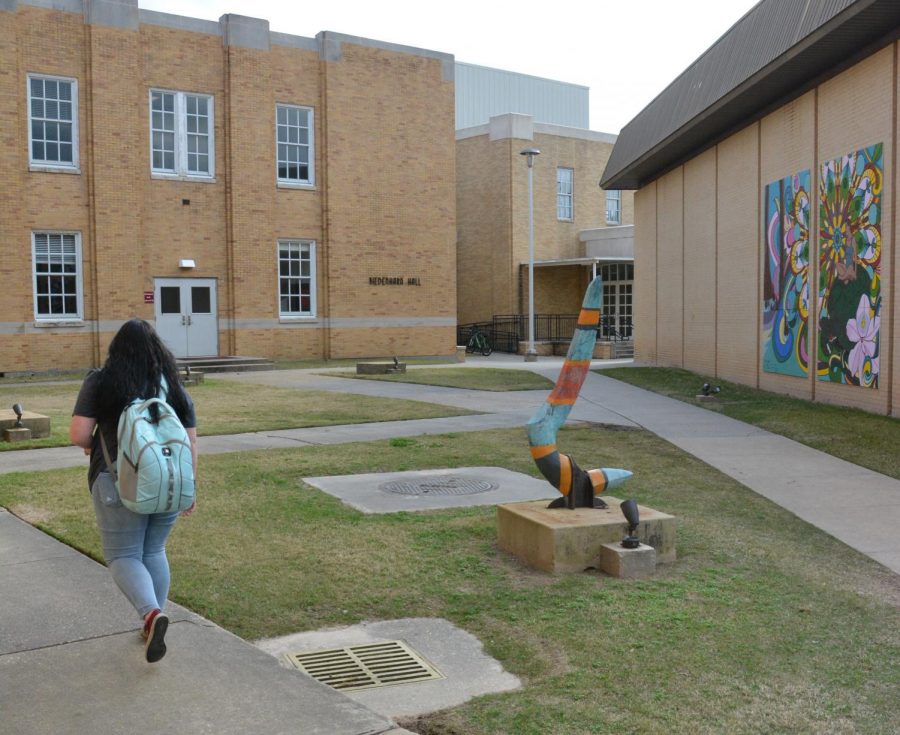ULM Sculpture Garden to not exist after upcoming summer
February 24, 2019
Everyone, especially the young, likes to have fun and time to relax. However, infants, toddlers and preschool children at the ULM Child Development Center will have to find a new place to do so very soon.
Already having cancelled their trip this semester, their biannual trip to the ULM Sculpture will have to be permanently relocated since no sculptures will remain after the summer.
The ULM Sculpture Garden began in 2005 with money provided by the 2004 graduating class. However, funding for the garden has been hard to acquire since 2013.
“There have been many funding sources over the years. For the last few years, it was funded by awards from the Student Activity Enhancement Fee (SAEF). The sculptures used to change every year, but after limits were put on funding amounts, the rotation went to every two years in the 2014 season,” said Clifford Tresner, the coordinator for the garden.
ULM’s associate art professor Tresner became the coordinator for the garden because of his involvement in the sculpture field.
Every two years, a national call for entries is sent to a list of contacts, but only five or six works are selected for display for the two-year period. Some of these sculptures are pre-made, while others are made specifically for the exhibit, which is located between Spyker Theater, Biedenharn Hall and the Sound of Today Band Building.
In spite of them being responsible for the delivery, setup and takedown of their work, art has been shown from artists based in Louisiana, Minnesota, Tennessee, North Carolina, Florida, Arizona, Texas, Mississippi, Missouri, Georgia and South Carolina.
Artists will no longer have this chance if funding is not found soon. Funding from the SAEF is no longer an option, since the guidelines for funding this fee has been modified to not include exhibitions, according to Tresner.
“I have notified the administration that there is currently not a funding source for these exhibition spaces,” Tresner said.
So, the future of the garden looks nonexistent. The removal of five of the six sculptures has already started affecting the Monroe community. Emily Williamson, the director of ULM’s Child Development Center, brings children aged six weeks to five years old to the garden to expand their creative thinking and expression skills.
“With the infants and toddlers, we want them to respond and show interest in visual stimuli and begin exploring with art materials. With our preschoolers, we want them to participate in various forms of creative activities, develop verbal skills by describing general features in a piece of artwork, observe and/or describe what they like and do not like about various forms of art and how it makes them feel,” Williamson said.
Speaking to the need for the garden, Williamson said, “It is one thing to see a sculpture or mural in a book, but until children actually see and explore one in real life, it doesn’t actually come alive.”
This space is used for many things including discussion and class dialog for ULM courses. Every spring, ULM’s School of Visual and Performing Arts hosts a Director’s Gala there where the Monroe community raises money for the department.
“The space contributes to the campus community and culture in a positive way. Faculty have mentioned they were pleased to see the space while interviewing for a faculty position here. The arts can help beautify an otherwise sparse area, and I hope the works presented over the years have sparked dialog and conversations among college students at a level expected at an institution of higher learning,” Tresner said.
Some students will be unhappy should the sculpture garden disappear.
“I think the sculpture should be kept on campus. It’s one of the gems on campus that people should see. Some consider it to be an eyesore, but it’s an important area to the art program and the artists who have works presented there,” said Trey Gordon, a junior art major.
The ULM Sculpture Garden even had plans once to travel works between the Masur Museum of Art and Public Art and ULM, but a lack of funds hindered this.
According to Tresner, at one time, “There were funds to provide ULM art students with material to design and make large scale work. These works were shown in the garden for a year, then many were shown on the grounds of the Masur Museum.”
The ULM Sculpture Garden has provided a space for art and education to coexist since 2005. The re-maining sculpture, “Pretending to Be” by Roger Halligan of Tennessee, can still be found facing Caldwell Hall.




Roger Halligan • Feb 28, 2019 at 2:51 pm
I would be more than happy to donate my work which is presently in the garden.